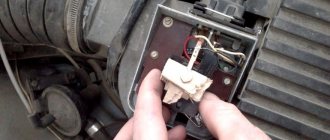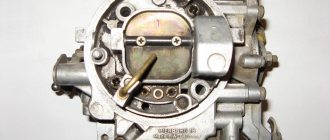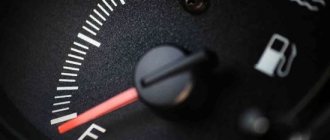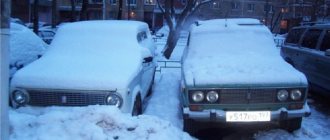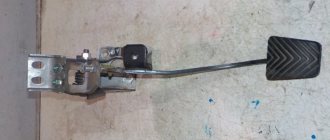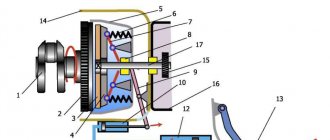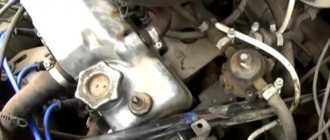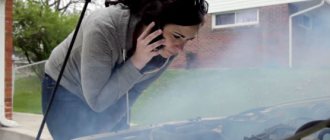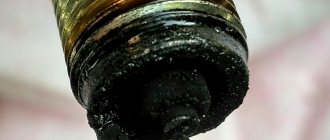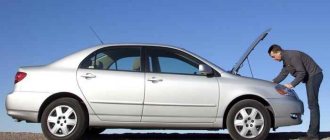During the operation of a car, regardless of the type of engine (gasoline, diesel), displacement, number of cylinders, layout and other features, problems such as: unstable idling, speed floats at idle and/or under load, the engine stalls when pressing brake, etc.
Also, the engine often stalls when the clutch is depressed, which greatly complicates the driving process and can even pose a certain danger. In this article we will talk about why the engine stalls when the clutch is pressed, as well as how to detect and fix such a problem.
The main reasons why the engine stalls
Experts assure that the circumstances under which the engine stalls can help to understand the problem of a stalling engine. But first, it’s worth talking about the most common problems that can lead to engine stalling.
The first thing you should start with is checking the fuel system, and this needs to be done with a banal thing - checking for the presence of gasoline in the gas tank. If it is not there, then the problem can be solved by simply visiting a gas station and refueling the car. If you just refueled, then the problem may lie in low-quality gasoline.
If you are sure that the cause of the engine malfunction is not related to fuel, then you need to remember how long ago the fuel and air filters were replaced. If the filters are heavily clogged, the natural process of mixture formation in the engine is disrupted, which manifests itself either in a lack of fuel or in a lack of air - as a result, the engine loses power, the car may begin to twitch and stall.
The problem may be caused by air leaks, excess of which can leak into the vehicle’s fuel system through poorly tightened connections or leaky pipes, which can be eliminated by simply tightening the clamps or completely replacing the pipes.
The engine stalls:
- When changing gear, as well as at neutral speed.
- While pressing the gas.
- When the engine speed is reduced.
It is worth noting that the causes of problems for injection and carburetor engines are usually different. Another important factor is at what time the engine stalls: cold or hot.
The reasons may be the following:
- Poor quality gasoline. Engine malfunction may occur due to refueling with low-quality fuel. Any knowledgeable driver will ponder when and where the last gas station was filled. There are cases when, after refueling at another station or with a different brand of fuel, the car begins to stall while driving.
- Faulty spark plugs. If, while driving, along with a sudden stop of the engine, the car makes sudden movements in the form of jerks and starts poorly, then the reason is in the spark plugs.
- Fuel filter. Another cause of malfunction is a dirty fuel filter. Over time, as the fuel mixture passes through, the filter becomes clogged with waste. If there is a fault in it, it should be replaced.
- Why the car stalls while driving is due to a faulty fuel pump. With this malfunction, fuel cannot flow normally into the aggregate system; in this case, you simply need to replace the pump.
- The battery must be kept clean, the terminals must be cleaned on time, since without proper care they either oxidize or become clogged.
- The generator is a very serious and important part of the car. If it malfunctions, all energy consumption falls on the battery, which, without the support of a generator, can very quickly discharge, and the car will not just stall, but will stand somewhere in the middle of the road until it receives a charge.
- Air filter. When it becomes contaminated, a failure occurs in the timely enrichment of the fuel mixture. Very often, car owners forget to change the filter in a timely manner, which leads to malfunctions and breakdowns.
- Optional equipment. With a large number of installed additional parts that provide comfort to the owner, a huge amount of energy is consumed. The car begins to stall because it does not receive enough charge to operate normally.
In the case of a stalled engine at the very beginning of operation, when the car has not yet warmed up and the engine is not hot, the following problems may occur:
- The air-fuel mixture supply system is faulty.
- The automatic throttle is faulty or the adjustment is incorrect.
- Thermostat malfunction - if this part breaks down, the engine will not be able to warm up normally and give the required speed.
- Fuel injectors are very dirty.
- The coolant sensor is broken.
DETAILS: Which Car Shampoo is Best for Washing a Car TOP 7 Shampoos
In this case, the automatic transmission should be diagnosed. The repair of such a malfunction should be entrusted to specialists. Usually, in car services, immediately after diagnostics, at the driver’s request, the auto mechanic disassembles and sorts out the box and fixes the problems. Usually the box does not need to be completely replaced.
Main reasons
The car may stall after starting the engine for several reasons, both when it is cold when first starting, or when it is hot. The problem manifests itself on injection and diesel units, for which there are quite a few reasons: from lack of fuel to more complex malfunctions associated with the fuel line or even the engine.
It is necessary to identify as early as possible the reason that the engine starts and immediately stalls. Otherwise, the car will not be able to be used.
When cold the engine starts and immediately stalls.
There are several simple reasons why a car may stall immediately after the engine starts:
- Running out of fuel is a simple reason, but because of this it is often overlooked. During long breaks in operation, fuel condensate may drain from the walls of the tank, with which the car can start. There is not enough gasoline for further operation, which is why the car stalls.
- Bad diesel or gasoline - if the fuel was purchased at dubious gas stations, the composition contains additives, even water. They have a bad effect on the fuel system and its filters. Additional Information! In diesel engines, paraffin added to the diesel composition can harden. Its particles clog the filter that cleans the fuel, causing the pressure on the fuel line to drop.
- Car alarms - advanced security systems can not only trigger when installed in a car, block the steering wheel locks, but also prevent the engine from running. If such a system is installed, you should check its deactivation.
- No vacuum - This problem occurs in carburetor cars if there is air in any part of the fuel supply. This could be the carburetor itself, the intake manifold, or the vacuum hose. The mixture of fuel and air has completely different proportions, which is why the engine cannot operate normally.
- Low idle speed is a common problem in carburetor cars, because in injection cars the speed is adjusted automatically. You will need to manually adjust the idle speed with the carburetor. It can correct the situation, since the engine will consume a normal amount of gasoline.
These are the main reasons why there are problems with starting cars, including carburetor-type ones. But there are still injection machines that require consideration.
The engine starts and the injector immediately stalls
An injector is a part that injects fuel into the engine and is sensitive to voltage changes. There are a number of reasons why an injector stalls:
- problems with the fuel system: the fuel pump is checked. This is easy to do; you need to turn on the ignition; if you hear a buzzing sound, the pump is working. If there are no sounds, you need to check whether voltage is supplied to it;
- dirty throttle: if the idle air control is contaminated with carbon deposits, air passes through it less easily, which means the engine operates in abnormal mode. A breakdown of the throttle valve also plays a role: if it is closed, no air enters the engine;
- Ignition system problem: If the fuel system and air supply are operating as normal, check for sparking. The spark plugs are being studied, they should be unscrewed, cleaned, and checked for a spark. The easiest way is to attach an armored wire to the spark plug and crank the crankshaft with the starter. Damaged wires may be to blame for the situation; they can be checked with a tester and a megger. If they are not there, you should start the engine in the dark. If part of the system is damaged, high-voltage discharges can be seen on the coils, conductors and tips;
- breakdowns of sensors and ECUs: electronic engine management systems control all motor power elements using information coming from the sensors. If any of them are damaged, the power unit may not only stall, but also refuse to start. If there are problems with the ECU, you can find out about them by the “Check Engine” indicator on the dashboard. To find a fault, read errors using a scanner;
- “out of sync” of the valves: the valve timing in the car could be out of sync, for example, due to the timing belt stretching or being misaligned. Aligning the shafts to the marks or replacing the belt with a new one will help.
What's the result?
Taking into account the above information, it becomes clear that most often the engine stalls when the clutch is depressed due to problems with idle speed.
As you know, the IAC and throttle position sensor are responsible for idling. Finally, we note that the car can stall even after the LPG installation has been carried out. In this case, it is necessary to contact the installation service so that qualified specialists make all the necessary settings of the gas equipment and the corresponding adjustments to the gas equipment.
The main reasons why the engine starts to stall after warming up. Frequent problems of carburetor and injection engines, fault diagnosis.
The engine stalls at idle: what to check. Possible causes of malfunction on engines with a carburetor, injector, and diesel power plants.
At idle the speed “floats”: why does this happen? The main malfunctions associated with idle speed on gasoline and diesel engines.
The car engine starts and stalls immediately after starting: the main causes of this malfunction. Diagnosis of possible causes, tips and recommendations.
Floating engine idle speed when cold. Basic malfunctions, symptoms and identification of breakdowns. Unstable idling of the diesel engine.
Causes of difficult “cold” starting of a diesel engine. Compression, glow plugs, diesel injectors, injection pump, paraffin or water in the fuel system.
The engine stalls at times
This phenomenon may be due to problems in the ignition system. When driving, random interruptions with sparking on the spark plugs are likely, both on a certain one and on all of them at once. The lack of a spark will most likely lead to the unit stopping.
If a car stalls while driving and then starts later (VAZ 2112 in particular), then the most common reasons include the following: malfunction and the presence of water in the ignition coil, damage to the crankshaft position sensor and ignition module, breakdown of safety parts of sensor control systems
In this case, pay attention to the condition of electrical wires and their connections, which can contribute to power outages
Misfire VAZ 2107 injector
The VAZ 2107 ignition module (injector) is a unit whose malfunctions are quite difficult to diagnose.
Problems with the module's operation are noticed only after serious engine malfunctions occur. If the engine does not start, you should try adjusting the ignition. If the engine is running unevenly, a serious check of the functionality of the VAZ 2107 ignition module may be required. Ignition is an electronic system for converting the low voltage of the vehicle's on-board network into high voltage and supplying the latter to the electrodes of the spark plugs.
Looking for reasons
All of the above reasons, with the exception of a breakdown of the crankshaft sensor, can be determined independently in a minimum of time. First of all, you need to understand whether the combustible mixture enters the combustion chambers of the engine. To do this, you need to unscrew and examine the spark plugs. If the spark plugs are dry, then the cause is most likely in the fuel system. In a carbureted car, the cause most often lies in the carburetor. There are many reasons, ranging from clogged fuel jets to lack of fuel in the float chamber. The fuel level in the float chamber is controlled by a needle valve connected to the float. The float may cling to the chamber body and not open the valve.
Clogging of the needle valve or jets can be caused by the ingress of foreign unfiltered particles or tar deposits as a result of using low-quality fuel. Resins are washed off using aerosol cans with carburetor cleaner, and blockages are washed off with a stream of air from the compressor.
Wet spark plugs indicate that the engine has a working fuel system.
You should immediately check the ignition system for the presence of a spark. If all the spark plugs have traces of fuel and a spark, then conclusions can be drawn about the serviceability of the ignition and fuel supply systems. It is worth warning that the malfunction of a single spark plug or spark plug wire cannot lead to the engine stopping. This happens if the ignition distributor - distributor, module or ignition coil - fails.
The camshaft drive belt can be viewed by removing its cover. On many cars, a broken timing belt is accompanied by a strong blow when stopping. This occurs as a result of uncoordinated movement of the valves and piston and their mutual impacts. The pistons do not have grooves, which is why they collide with the valves
On such engines, special attention should be paid regularly to checking the condition of the belt. Some engines have grooves on the pistons, so a break in the timing belt goes completely unnoticed for them.
The collector shaft position sensor can only be checked by installing a new one on the car. None of the engine sensors will cause the engine to stop anymore, since the on-board controller has several backup operating algorithms and will ensure engine operation, albeit with increased fuel consumption and reduced power. At first, you can continue driving with such breakdowns.
The operation of the electric fuel pump of injection cars is checked by the presence of fuel in the fuel rail.
Checking the ignition system elements
Misfires in engine operation, especially in wet weather, are a consequence of breakdown of the insulation of high-voltage wires. There should be no cracks or damage in the wire insulation. You can check the insulation for breakdown using a wire connected to ground. If you run it along the insulation while the engine is running, a spark will be observed in places with damaged insulation. Another clear sign of poor insulation is noticeable electric shocks when touching high-voltage wires while the motor is running.
A broken high-voltage wire can be easily determined with an ohmmeter. The resistance should be between 3-10 kOhm. The spread of indicators between the wires should be no more than 1-2 kOhm.
Everyday situations if the car stalls
What else can affect the engine and the quality of its operation?
- Summer. Heat. Many car enthusiasts do not take into account the fact that this is an additional load on the engine.
- Vapor lock in the fuel pump. Gasoline simply boils, its supply stops, and the engine stalls.
- The fuel pump petals are worn out and the engine will not start. Many drivers take a water bottle with them in the summer. By moistening a rag with water and placing it on the pump, you can significantly speed up its cooling.
- Cleaning filter with too fine a mesh. When ascending (or descending), gasoline does not flow into the pump, and the car stalls.
- The car was caught in the rain and water got under the hood. The terminals may have been damaged. In such a situation, do not open the hood or try to start the car!
You can make an appointment for diagnostics and repair of your car by appointment by calling our auto center: 8 (0222) 44-17-84, +375 (29) 699-40-03, +375 (29) 538-80-03
avtoexperts.ru
No matter what kind of car you have, expensive and reliable, absolutely no one is immune from the fact that one fine day, in the morning before going to work, it may simply stall immediately after starting. In this essay we will try to cover all theoretically and practically possible causes of this trouble.
What usually happens is this: you turn the key in the ignition, the engine starts, a few seconds pass, and the revolutions on the tachometer rapidly drop down to zero, and eventually the engine stalls.
First of all, you need to understand the reason.
Surprising as it may be, check the presence of fuel in the tank, since the liquid level sensor could simply have failed and you simply ran through all the gasoline, and the car did not inform you about its low balance.
If you are sure that the fuel level is OK, then try to restart the engine.
When you try to start again, listen to the operation of the pump; the electrical power circuit may be interrupted, or there may be a mechanical failure. If the pump hums, it pumps fuel to the fuel rail, and that's good.
The next step is to check how the air flows. To do this, remove the casing on the air filter and check it for critical contamination. If the filter is in order, we put it back in the box and check the rubber air supply pipes.
If everything is in order with them, then the only simple thing you can remember is removing the positive terminal from the battery for a short time so that the information on the electronic control unit is updated and all active errors are erased.
If this does not help, then you can no longer cope with the problem on your own and you need to contact the service for qualified help.
But what could be the reasons that the engine starts and then stalls?
1. Loss of power supply to the sensors or their failure. For example, such as MAF (Mass Air Flow Sensor), crankshaft position sensor, EGR, or throttle position sensor.
2. The spark on the spark plugs is insufficient for stable operation of the internal combustion engine. The reason may lie in insulation breakdowns on the armor wires, failed ignition coils or ignition distribution module, and finally, in the spark plugs themselves.
3. If your car has a diesel engine, and the temperature outside drops below -10 degrees, then there is a high probability that the glow plugs have failed.
4. If your car has an additional alarm system with an immobilizer bypass module, then there is a possibility that the standard electrical system is in conflict with a foreign one. If all anti-theft systems have not undergone any intervention, you still need to check the standard immobilizer for correct operation. If the immobilizer does not read the code from the key, it does not turn off, then the car thinks that it is being stolen, and the electronics turns off the engine.
5. The engine may stall due to improper operation of the injectors, or their complete failure. The fuel simply does not enter the combustion chamber.
6. The throttle valve requires cleanliness, and its contamination can also be the reason why the engine immediately stalls after starting
This is especially worth paying attention to in regions with poor fuel quality.
7. Well, finally, the worst thing is a malfunction of the gas distribution mechanism. If you have a timing belt drive (gas distribution mechanism), then everything is simple. If not done correctly, it will simply break. But if your camshafts are driven by a chain, then everything is a little more interesting. The chain tends to stretch, and therefore can jump on the gears, due to which the intake and exhaust valves may begin to operate incorrectly, and a failure may occur either during the intake of the fuel-air mixture, or during the release of exhaust gases, due to why the car may stall, may not start at all, or may simply run unstably.
The simplest reason for a failed start may be poor quality fuel or fuel diluted with water. In this case, in an amicable way, after draining the unknown substance from the fuel tank, you need to completely flush the entire fuel system and replace the fuel filter.
Well, the simplest thing that can be recommended to ensure that the car is always in order is to refuel only at proven gas stations and periodic preventive visits to the service center for diagnostics. A car is a complex mechanism, but even it does not break down instantly. A good half of the breakdowns could have been prevented in the early stages.
Messages 18
1 Topic by vagan.82 2012-11-25 21:23:17
- vagan.82
- New member
- Inactive
- From: Chelyabinsk
- Registration: 2012-11-25
- Messages: 8 Thanks : 1
Topic: Resolved: Stalls while driving with clutch depressed
VAZ 21124 2005 pr. 120t starts up when the clutch is depressed and immediately stalls. while driving, you squeeze the clutch, the speed drops very quickly to zero, if you don’t give it some gas, it will stall 100%. I did 2 diagnostics, the result was 0. IAC, TPS, CANDLES, AK-B, DTOZH were changed. Help, maybe someone knows where to dig
2 Reply from aleks-nk 2012-11-26 03:39:38
- aleks-nk
- Participant
- Inactive
- From: Novokuznetsk
- Registration: 2012-02-25
- Messages: 136 Thanks : 29
- Car: VAZ 21102 1.5 8kl 2004 Niagara
Re: Resolved: Stalls while driving with clutch depressed
Try changing the mesh on the fuel pump and the fuel filter, then drive for 15-20 minutes at 3500-4000 rpm (as they say, let it shit
) this happened several times - it helped, he referred to the fact that a speck got into the fuel line)
3 Reply from Admin 2012-11-26 04:13:29
- Admin
- Administrator
- Inactive
- Registration: 2012-02-20
- Messages: 3,257 Thanks : 624
Re: Resolved: Stalls while driving with clutch depressed
vagan.82 , try to use the tips from this topic The engine stalled while driving
4 Reply from iliaBkmz 2012-11-26 09:19:05 (2012-11-26 09:23:44 edited by iliaBkmz)
- iliaBkmz
- Forum legend
- Inactive
- Registration: 2012-11-12
- Posts: 2,042 Thanks : 584
- Car: outlander and 2104
Re: Resolved: Stalls while driving with clutch depressed
What kind of diagnostics did you do? Have you done diagnostics on the fuel system? Checking for air leaks?
But start with this: check what the root cause is. Does the car react to pressing the brake pedal? The clutch pedal is not related to the speed in any way (well, only if it is not adjusted correctly), but if at XX when the brake is pressed it reacts to the brake pedal (it stalls when pressed), it means it is sucking through the VUT. If the brake pedal does not respond, check for general air leaks, check whether the hose has flown off from where (those that come from the receiver)
The car stalls when driving
Motorists may encounter the problem of stopping the engine while driving, the cause of which is often related to the presence of malfunctions in the ignition system.
So, an unexpectedly lost spark can lead to engine stalling, especially if we are talking about a cold engine.
The main reasons for the loss of spark are considered to be problems in the module or ignition coil, as well as malfunctions of the crankshaft position sensors.
In addition, unexpected voltage loss can be caused by loose wiring connections or corrosion in electrical connectors.
Quite often, the reason the engine stops while driving is a faulty generator, which stops providing a charge, as a result of which the car’s electrical systems are powered by the battery, which, as we know, lasts for a very short time.
In some cases, the problem may be associated with incorrect operation of electronics and various sensors - in this case, it is better to do without amateur efforts and seek help from specialists as soon as possible.
Checking the ignition coil
The coil is checked based on two indicators: the presence of a short circuit and an open circuit. Before diagnostics, the ignition coil must be disconnected. After this, one probe of the device is connected to the central contact of the coil, the second to the body (ground). If the display shows resistance equal to infinity, there is no short circuit.
The primary winding of the coil for a break occurs differently. The probes of the device must be connected to the right and left contacts. The resistance between them should be within 3-3.5 Ohms.
Bad firmware
Sometimes car owners try to improve the technical characteristics of the car by flashing it. Quite often, competent firmware can add horsepower to a car and make it more dynamic. However, firmware does not always improve the dynamic characteristics of the car; sometimes the opposite happens. Some software changes improve engine performance at crankshaft speeds above 1000 rpm, and at lower speeds the engine may stall. In general, illiterate firmware can be the answer to the question of why the car stalls while driving. In this case, the injector simply “does not understand” how often and in what quantities to supply the fuel mixture.
If such a malfunction appears after installing new firmware, then it is worth resetting the on-board computer to factory settings. And the problem will go away.
Solution
The procedure to correct the problem depends on the type of problem. If the engine stalls when you press the clutch or brake on a car with an injector, you can solve the problem yourself. Let's consider all cases of troubleshooting.
Read news about the new Niva
- Powerful homemade off-road all-terrain tricycle: photo and description of the design
- Photo review of the new MTLB with NSVT
- Tracked twin-engine all-terrain vehicle "Serenky"
- All-terrain vehicle fracture Bobik, Toptyga and some others
- "Intelligent" all-wheel drive - Page 15 - Discussion - Opel Antara Club
- The main malfunctions of the car clutch. signs, causes, solutions
- Chevrolet Niva and standard key fob. VAZ forum
- NIVA and NIVA-Chevrolet spare parts catalogs - Shop of auto parts and accessories for Niva and NIVA-Chevrolet cars
Why does the engine stall when I press the clutch?
Regardless of what engine is installed in your car, what size it has and how many cylinders it has, you may encounter a number of problems with its operation. One of the fairly common troubles is a stalling engine when the clutch is depressed. This is a rather serious situation, because... it not only complicates the driving process, but also entails a certain danger. In this regard, it will be useful to know why the engine stalls, as well as how to detect and fix this problem.
Let's start with the reasons. Unfortunately, there are many of them; here we will focus on the most common ones.
Often the car stalls at the moment when the clutch is pressed and the gas pedal is released. It turns out that the problem occurs when the throttle valve is closed, and the idle system is responsible for engine operation. On many cars, the cause of this problem is a faulty idle speed sensor. Thus, if, when coasting, the rpm drops sharply when you take your foot off the gas, depress the clutch or press the brake, then you need to change the XX sensor.
Another common cause of the problem is a heavily dirty or damaged throttle body. To solve the problem, you need to clean the throttle valve or replace faulty elements.
If the problem is not in the throttle assembly, then you should take a closer look at the throttle position sensor. It tells the electronic control unit how open or closed the damper is. Problems arise if the data transmitted by the sensor does not match the actual position. The situation can be corrected by replacing the sensor.
The next probable cause may be hidden in the power system. First, you should check the condition of the air and fuel filters, because if they are heavily contaminated, then at idle there may be insufficient fuel or air to create the “correct” mixture.
Having checked the filters, we move on to assessing the condition of the injection nozzles. If they are dirty, then insufficient fuel may enter the cylinders.
And finally, we check the fuel pump: if the performance is insufficient, the fuel pressure will be low and the engine will start to stall.
What to do?
Fortunately, many causes of a stalled engine can be eliminated without resorting to paid specialist help. Almost any driver himself can clean the throttle assembly, replace spark plugs, filters, sensors, etc. To make it easier for you, we offer step-by-step instructions on how to carry out such “repairs” on your own.
Replacing the idle air control.
- Remove the terminals from the battery. We determine where the sensor is located. We unclip the chip with wires from it, unscrew the fastening screws and remove the regulator.
- We install a new sensor. If it has rubber sealing elements, make sure that they fit tightly to the surface.
- We are calibrating the new regulator. To do this, we put the terminals on the battery and turn on the ignition for 5-15 seconds. That's it, you can test run the engine.
Cleaning the throttle valve.
For this operation you will need a special cleaner, for example, carburetor cleaning fluid. We dismantle the assembly as described in the repair instructions for your car, then wash the damper and channels with a cleaner
It is also important to clean the crankcase ventilation channel, for which you can simply supply air there under pressure (with a compressor, for example). When you remove the throttle, inspect the rubber gaskets of the assembly - if there is any damage to them, the seal must be replaced
Replacing the fuel filter.
In the fuse box we find the fuel pump fuse and turn it off. We start the engine and wait until it stalls. Next, we look for a fuel filter (it can be under the hood, outside on the bottom, in the area of the gas tank - it varies from car to car). We unscrew the filter and the fuel pipes attached to it. Install a new filter. When installing the filter element, keep in mind that the arrows on the housing indicate the movement of fuel in the direction from the tank to the power unit. When the filter is installed and all fasteners are tightened, turn on the fuel pump by reinstalling the fuse
After this, you can turn on the ignition for a few seconds so that the pressure in the system increases. After starting the engine for the first time, it is important to carefully inspect the installation location of the filter. There should be no fuel leaks at the connection point of the fuel pipes and along the filter housing.
To summarize, we can say that most often the problem of a stalling engine is associated with idle problems. And because The throttle position sensor and the idle speed sensor are responsible for it, so these are the elements that should be checked first if your engine begins to stall when the clutch is depressed.
Second reason - Fuel pump
Unfortunately, there is no warning that your fuel pump is about to fail. The first time you notice any problems is only after the car stalls. And with this malfunction, the car cannot be started again.
The serviceability of the fuel pump can be determined by a characteristic slight buzzing sound when the engine starts. If you don't hear any noise from the fuel tank when you try to start your car, it's likely that your fuel pump has failed. Since the car will not move with this problem, all you can do is tow the car to a car service center.

